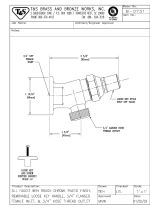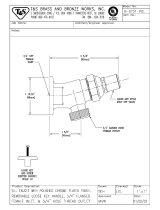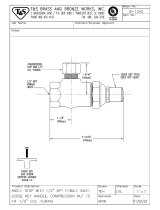
Installation - Operation - Maintenance
9982 E. 121
st
Street
Fishers, IN 46037
(888) 900-0947 (800) 900-8654 Fax
info@nexusvalve.com www.nexusvalve.com
3
For valve bodies with integral sweat fittings, special care must be taken to avoid overheating the seals, o-
rings, and sealant used in the valve body assembly. Position the valve lever or handle in the open position to
eliminate pressure buildup and dissipate heat and use a heat sinking method.
FAILURE TO PROTECT THE VALVE BODY AND SEALS CONTAINED WITHIN THE VALVE BODY FROM
OVERHEATING WILL CAUSE THE SEALS TO FAIL, THE VALVE TO LEAK, AND WILL VOID THE NEXUS
VALVE WARRANTY.
For valve and/or union bodies with a sweat type union end tail piece, the tail piece must be removed from the
valve or union body before heat is applied to avoid damaging the union o-ring.
NexPress™ Connections
The NexPress™ connection is for use with Types K, L, and M hard copper tubing. The maximum working
pressure on the NexPress™ fitting is 200 psi and is manufactured for water and water/glycol systems. For
the connection to work “leak free” it is mandatory that the end of the copper tube be properly “dressed.”
Failure to “dress” the tube properly will result in a torn or damaged o-ring and result in a weak or leaking
seal. To properly use NexPress™ fittings:
• We recommend not using pipe fittings that do not have the required length of straight pipe. If using
pipe fittings, be sure to properly dress them.
• Cut the end of the tube square.
• Remove all dirt, debris & burrs inside and outside.
• Chamfer the leading edge of the tube 5mm by 30 degrees.
• Ensure that the o-ring is present in the fitting, check that the o-ring is positioned evenly in the fitting’s
groove and is free of dirt, oil or other foreign materials.
• Insert tubing into the fitting, ensure that the tubing inserts fully into the fitting.
• If the tubing is difficult to insert, a little water or a food grade silicone spray may be applied to the
tubing.
• Once the tubing is fully inserted, the fitting must be crimped using crimping tools, Ridgid ProPress,
Stanley, NIBCO, etc.
• A minimum distance between press fittings must be ½ the tubing diameter.
• Consider clearance requirements between wall/ceiling & piping for the press tool.
• When transistioning to threaded connections, the threaded connection is made first.
• A minimum distance, when pressing a connection near an existing brazed fitting, of 2x the tubing
diameters is required.
• A minimum distance, when pressing a connection near an existing solder fitting, of ½ the tubing
diameters is required.
• When soldering near a NexPress™ connection a minimum distance of 3x tube diameters is required.
• When brazing near a NexPress™ connection a minimum distance of 9x tube diameters is required.
• A minimum distance of 4” must be maintained when welding a pipe adjacent to a pipe with a
NexPress™ connection.


























